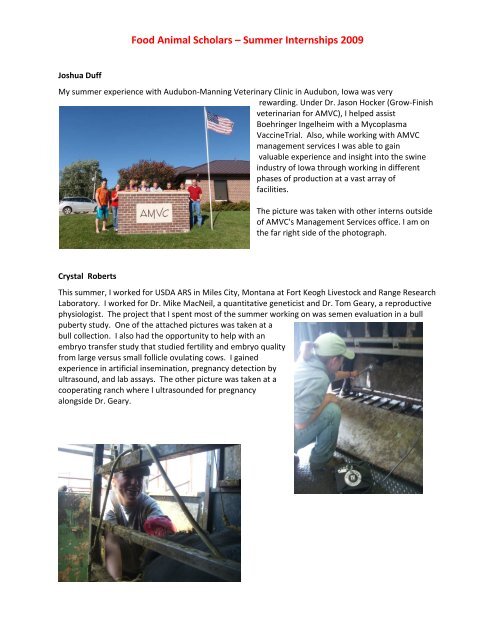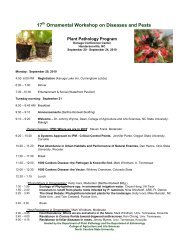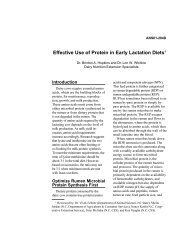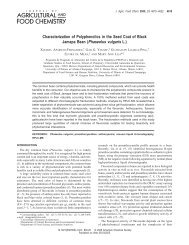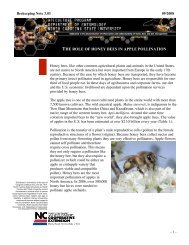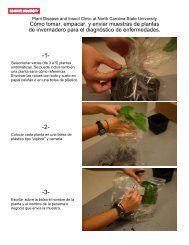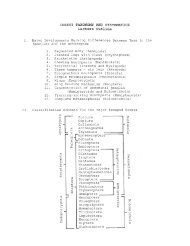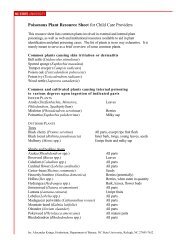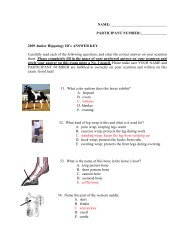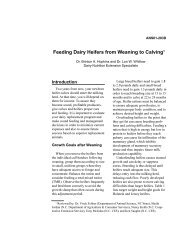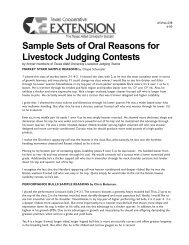Summer Internships 2009 - North Carolina State University
Summer Internships 2009 - North Carolina State University
Summer Internships 2009 - North Carolina State University
Create successful ePaper yourself
Turn your PDF publications into a flip-book with our unique Google optimized e-Paper software.
Joshua Duff<br />
Food Animal Scholars – <strong>Summer</strong> <strong>Internships</strong> <strong>2009</strong><br />
My summer experience with Audubon‐Manning Veterinary Clinic in Audubon, Iowa was very<br />
rewarding. Under Dr. Jason Hocker (Grow‐Finish<br />
veterinarian for AMVC), I helped assist<br />
Boehringer Ingelheim with a Mycoplasma<br />
VaccineTrial. Also, while working with AMVC<br />
management services I was able to gain<br />
valuable experience and insight into the swine<br />
industry of Iowa through working in different<br />
phases of production at a vast array of<br />
facilities.<br />
Crystal Roberts<br />
The picture was taken with other interns outside<br />
of AMVC's Management Services office. I am on<br />
the far right side of the photograph.<br />
This summer, I worked for USDA ARS in Miles City, Montana at Fort Keogh Livestock and Range Research<br />
Laboratory. I worked for Dr. Mike MacNeil, a quantitative geneticist and Dr. Tom Geary, a reproductive<br />
physiologist. The project that I spent most of the summer working on was semen evaluation in a bull<br />
puberty study. One of the attached pictures was taken at a<br />
bull collection. I also had the opportunity to help with an<br />
embryo transfer study that studied fertility and embryo quality<br />
from large versus small follicle ovulating cows. I gained<br />
experience in artificial insemination, pregnancy detection by<br />
ultrasound, and lab assays. The other picture was taken at a<br />
cooperating ranch where I ultrasounded for pregnancy<br />
alongside Dr. Geary.
Ben Winslow<br />
I spent my summer at a feedlot in southwestern Kansas. For most of the time, I was with the doctoring<br />
crew, helping heal sick animals. I learned about potential health problems of feedlot cattle and how to<br />
treat them. I also learned from the pen riders how to identify animals that are not feeling well. My<br />
other major activity was helping to process the new arrivals, which gave me additional insight<br />
into the health challenges encountered by new cattle and how best to prepare their immune systems. I<br />
also spent a few days with the feed crew, learning the importance of a proper diet. Overall, it was a<br />
life‐enriching, powerfully educational experience.<br />
Ranette Goodwyn<br />
This summer I participated in the NCSU‐USDA Veterinary Career Pathways Internship. It was a ten week<br />
program, where eight weeks were spent in Raleigh, NC at <strong>North</strong> <strong>Carolina</strong> <strong>State</strong> <strong>University</strong> CVM and the<br />
USDA offices located on Centennial Campus, and two weeks were spent in Ames, IA at the National<br />
Veterinary Services Laboratories. Every day was a different experience. During our times at CVM, we<br />
spent Thursdays with Dr. Jill Barnes getting a preview of what veterinary students learn in their first<br />
semester of anatomy. We dissected a dog cadaver and learned about the bones, muscles, nerves,<br />
arteries and veins of the limbs and the internal organs. We also learned about Epidemiology and Public<br />
Health with Dr. Peter Cowen. With Dr. Allen Cannedy, we went out on several farm calls and got plenty<br />
of hands‐on experience with sheep, goats, llamas and even a yak while we did hoof trimmings, collected<br />
and processed fecal samples, shearing and general physical exams and vaccinations.<br />
While working with the USDA, we learned about all their branches, such as APHIS, Veterinary Services,<br />
Wildlife Services, Animal Care and PPQ and got to spend<br />
time out in the field with employees under each branch.<br />
One of my favorite times was spent with Wildlife Services<br />
while we did a "goose round‐up," on a flock of Canadian<br />
Geese removed from the premises of a correctional<br />
facility. We did Avian Influenza sampling on each bird by<br />
performing age and gender determination, tracheal and<br />
cloacal swabbing and cardiac bleedings. We assisted in<br />
inspections of a ranch and a garbage feeder farm and we<br />
also collected brain stems for BSE sampling.<br />
During the two weeks spent in Iowa, one week was spent at the Center for Veterinary Biologics<br />
Laboratory and the second week was spent at the National Veterinary Services Laboratories. We learned<br />
a variety of laboratory techniques and tests such as agarose gel electrophoresis, DNA extraction, egg<br />
inoculation and PCR. Time also was spent in the parasitology lab, where we performed tick<br />
identification, and the histology labs, where we learned how to make slides from start to finish.<br />
There are many more experiences we had this<br />
summer, but this is just shows the wide variety<br />
of the things we did. I would highly recommend that<br />
future FAS students participate in this program<br />
because it really shows just how much veterinarians<br />
can do with their degree and it just may open their<br />
eyes to a career they never thought of before.
Holly Parkins<br />
My summer experience took place in Wayne County, Ohio as<br />
well as Haywood county <strong>North</strong> <strong>Carolina</strong>, both of these were on<br />
Dairy Farms as well as working with some Vets on other Dairies<br />
in the surrounding area. During my time at Catalpadale Farms in<br />
Ohio, a 1,600 head Dairy with another location in Central<br />
Kentucky milking around 1,400 head owned and operated by<br />
John and Lois Douglas. (Photos are all from Ohio) I worked the<br />
majority of my time with the herdsman starting around 6:00 or<br />
6:30am and working<br />
~10hrs a day 6 days a<br />
week. Each morning we began with checking all cows in the<br />
I.C.U. and post‐fresh pen. This included taking temps, checking<br />
rumen activity, palpation, practicing infusing and giving lots of<br />
dextrose, calcium and hypersaline IVs as well as Banamine,<br />
Exceed and other routine medical shots and pills. During the<br />
month of June the farm calved in 200 cows and heifers so<br />
there were plenty of animals to look after. I also helped in<br />
vaccinating and<br />
moving lots of<br />
heifers and lots of other dairy work. I was able to use my<br />
knowledge of Spanish to communicate with the Hispanic<br />
workers and also watched and assisted with many D.A.<br />
surgeries, and also watched one Roll and Tack procedure.<br />
During my time on the farm in NC which is my family's Dairy<br />
I did many of the same things, but on a much smaller scale.<br />
I also practiced palpating with the Vet. During our herd<br />
check, milked and managed the calves, and<br />
other farm duties.<br />
Food Animal Scholars Program:<br />
http://www.cals.ncsu.edu/an_sci/FoodAnimalScholars/


